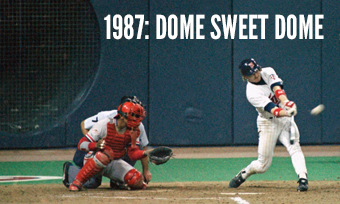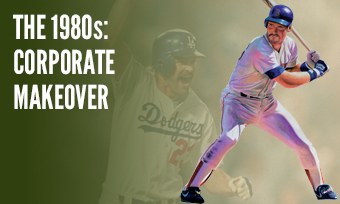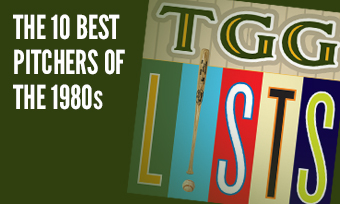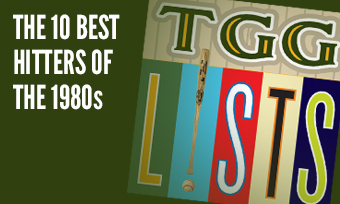The Yearly Reader
Leaders and Honors, 1987
Our list of baseball’s top 10 hitters and pitchers in both the American League and National League for the 1987 baseball season, as well as the awards and honors given to the game’s top achievers of the year.
The National League’s Top 10 Hitters, 1987
Bold type in brick red indicates league leader.
1. Eric Davis, Cincinnati
Key Numbers: 129 games, .293 average, 120 runs, 37 home runs, 100 RBIs, 84 walks, 50 stolen bases, 6 caught stealing.
Davis came to the majors with far less fanfare than his high school buddy Darryl Strawberry (#2 below), but showed incredible potential—realizing much of it before an endless string of injuries gradually eroded his superstar form.
2. Darryl Strawberry, New York
Key Numbers: .284 average, 108 runs, 32 doubles, 5 triples, 39 home runs, 104 RBIs, 97 walks, 36 stolen bases.
Strawberry’s phenomenal talent reached its apex before he too got sadly sidetracked—more by drugs than injury and, like Davis later, by cancer. He partnered with Howard Johnson to become the first teammates with 30-30 seasons.
3. Tim Raines, Montreal
Key Numbers: 139 games, .330 average, 123 runs, 175 hits, 34 doubles, 8 triples, 18 home runs, 68 RBIs, 90 walks, 26 intentional walks, 50 stolen bases, 5 caught stealing.
Forced to return to the Expos after colluding owners kept him from going elsewhere in a massive attempt to stifle wages, Raines sucked it up, had another excellent season…and got a belated payday a few years later from the courts.
4. Dale Murphy, Atlanta
Key Numbers: .295 average, 115 runs, 27 doubles, 44 home runs, 105 RBIs, 115 walks, 29 intentional walks, 16 stolen bases.
After his numbers softened in 1986, Murphy firmly rebounded and set personal bests in home runs and walks; he suffered an instant downturn a year later and hit only .234 for the remainder of his career.
5. Tony Gwynn, San Diego
Key Numbers: .370 average, 119 runs, 218 hits, 36 doubles, 13 triples, 7 home runs, 54 RBIs, 82 walks, 26 intentional walks, 56 stolen bases.
Gwynn shunned the homer but registered the NL’s highest average in 40 years. Unbelievably, he would record two higher averages in the years to come; more unbelievably, he would never score over 100 runs again, despite batting .340 over his remaining 14 years.
6. Jack Clark, St. Louis
Key Numbers: 131 games, .286 average, 93 runs, 35 home runs, 106 RBIs, 136 walks, 139 strikeouts, .459 on-base percentage, .597 slugging percentage.
Looking more bulked than ever, Clark went full ‘three outcomes’ on a revived Cardinals offense and evolved into a fearless (if fragile, toward season’s end) slugger, collecting either a home run, walk or strikeout in 55% of his plate appearances.
7. Andre Dawson, Chicago
Key Numbers: .287 average, 90 runs, 178 hits, 49 home runs, 137 RBIs, 11 stolen bases.
The Hawk easily soared to a career-high count of home runs and became the first MVP on a last-place team after practically begging the Cubs to sign him—to the point of handing them a contract with a blank dollar amount. (The Cubs wrote in $500,000.)
8. Juan Samuel, Philadelphia
Key Numbers: .272 average, 655 at-bats, 113 runs, 178 hits, 37 doubles, 15 triples, 28 home runs, 100 RBIs, 162 strikeouts, 35 stolen bases.
Samuel became the first major leaguer to produce double-figures in doubles, triples, home runs and steals. He would never return to such heights, failing to rekindle the early-career spark over 11 more seasons.
9. Mike Schmidt, Philadelphia
Key Numbers: .293 average, 88 runs, 28 doubles, 35 home runs, 113 RBIs, 83 walks.
Father Time was closing in on Schmidt—who turned 38 at season’s end—but he gave one last breath of Hall-of-Fame output, belting his 500th career home run, blasting three in one game for the third time, and producing his second-highest batting average.
10. Pedro Guerrero, Los Angeles
Key Numbers: .338 average, 89 runs, 184 hits, 25 doubles, 27 home runs, 89 RBIs.
Guerrero showed he hadn’t lost a step after missing most of the previous season with a torn tendon; his .338 average represented a career high, hitting over .400 in two separate months (July and September).
The American League’s Top 10 Hitters, 1987
1. Paul Molitor, Milwaukee
Key Numbers: 118 games, .353 average, 114 runs, 164 hits, 41 doubles, 5 triples, 16 home runs, 75 RBIs, 69 walks, 45 stolen bases.
A few astonishing facts about Molitor’s memorable (39-game hit streak) and painful (40 games lost to injury) season: He hit an insane .444 with runners in scoring position, and despite missing all that time, still led the AL in runs and doubles.
2. Wade Boggs, Boston
Key Numbers: .363 average, 108 runs, 200 hits, 40 doubles, 6 triples, 24 home runs, 89 RBIs, 105 walks, 19 intentional walks, .461 on-base percentage.
In a year where home runs trumped ace pitchers, Boggs rode the slugging frenzy to smack a career-high 24; he never hit more than 11 in any other season. To show it wasn’t all about the power, Boggs hit .390 when making contact on a 0-2 pitch.
3. Dwight Evans, Boston
Key Numbers: .305 average, 109 runs, 37 doubles, 34 home runs, 123 RBIs, 106 walks.
The tireless, ageless (35) Evans—who goes back to a time when he could claim teammates such as Carl Yastrzemski, Luis Aparicio and Bob Veale—continued to get better with each passing year.
4. George Bell, Toronto
Key Numbers: .322 average, 111 runs, 188 hits, 32 doubles, 47 home runs, 134 RBIs.
Bell’s Herculean year earned him the AL MVP, though it was a squeaker over Detroit’s Alan Trammell (332-311) in the final vote.
5. Alan Trammell, Detroit
Key Numbers: .343 average, 109 runs, 205 hits, 34 doubles, 28 home runs, 105 RBIs, 21 stolen bases, 2 caught stealing.
Trammell’s 20-year career in Detroit peaked—if not spiked—with a stellar effort in which he set personal bests in all major hitting categories.
6. Mark McGwire, Oakland
Key Numbers: .289 average, 97 runs, 28 doubles, 49 home runs, 118 RBIs, .618 slugging percentage.
The muscular rookie forfeited his shot at a 50th home run when he skipped the year’s final game to witness the birth of his first child. He probably figured he’d get a few more chances at 50 anyway.
7. Robin Yount, Milwaukee
Key Numbers: .312 average, 99 runs, 198 hits, 25 doubles, 9 triples, 21 home runs, 103 RBIs, 19 stolen bases.
Yount’s numbers returned to something closely akin to those produced during his first MVP season of 1982—and mirrored those he’d accrue two years later when he won his second such honor. He more than doubled his home run and RBI totals from 1986 despite playing just 18 more games.
8. Wally Joyner, California
Key Numbers: .285 average, 100 runs, 33 doubles, 34 home runs, 117 RBIs.
Life was good in “Wally World,” as the baby-faced sophomore—still fuming over finishing second to Jose Canseco in the 1986 AL Rookie of the Year vote—set career marks in the power categories.
9. Don Mattingly, New York
Key Numbers: .327 average, 93 runs, 186 hits, 38 doubles, 30 home runs, 115 RBIs.
Despite a poor start and the onset of back issues that would dog the latter half of his career, Mattingly remained one of the game’s sterling hitting talents; all 10 of his July home runs were hit within an eight-game stretch.
10. Kevin Seitzer, Kansas City
Key Numbers: .323 average, 105 runs, 207 hits, 33 doubles, 8 triples, 15 home runs, 83 RBIs, 12 stolen bases.
Among the rookie’s league co-leading 207 hits were six on August 2 against Boston, making him one of three Royals ever to collect that many in a game.
The National League’s Top 10 Pitchers, 1987
1. Orel Hershiser, Los Angeles
Key Numbers: 3.06 ERA, 16 wins, 16 losses, 1 save, 37 appearances, 35 starts, 264.2 innings, 11 wild pitches, 30 grounded into double plays.
With so much offense in 1987, undeserving .500 pitcher Hershiser had to wonder where all of his support was.
2. Rick Reuschel, Pittsburgh-San Francisco
Key Numbers: 3.09 ERA, 13 wins, 9 losses, 33 starts, 12 complete games, 4 shutouts, 227 innings, 42 walks.
The portly 38-year old received a second wind upon his trade to the Giants, finally feeling relevance with a contender after so many years playing for bad teams.
3. Bob Welch, Los Angeles
Key Numbers: 3.22 ERA, 15 wins, 9 losses, 35 starts, 4 shutouts, 251.2 innings, 20 stolen bases allowed, 18 caught stealing/picked off.
Entering the best stretch of his career—capped by a mind-boggling 1990 campaign for Oakland—Welch began a four-year run winning at least 15 while restricting defeats to the single digits.
4. Mike Scott, Houston
Key Numbers: 3.23 ERA, 16 wins, 13 losses, 36 starts, 247.2 innings, 39 stolen bases allowed.
Scott retained his brilliant 1986 pace to begin 1987—starting the year at 9-3 with a 2.10 ERA—but afterward was 7-10 with a 4.13 figure.
5. Mike Dunne, Pittsburgh
Key Numbers: 3.03 ERA, 13 wins, 6 losses, 23 starts, .684 winning percentage, 163.1 innings, 22 grounded into double plays.
A year of seconds for the 24-year-old right-hander who enjoyed his best of just five major league campaigns; he finished second in the NL in ERA, and second in the NL Rookie of the Year vote (behind San Diego catcher Benito Santiago).
6. Dwight Gooden, New York
Key Numbers: 3.21 ERA, 15 wins, 7 losses, .682 win percentage, 179.2 innings, 24 stolen bases allowed.
A sober Gooden might have been enough to push the Mets—25-25 until he returned from rehab on June 5—to a second straight NL East title over the Cardinals.
7. Tim Burke, Montreal
Key Numbers: 1.19 ERA, 7 wins, 0 losses, 18 saves, 4 blown saves, 55 appearances, 91 innings, 17 walks.
Burke did very little wrong as part of a share-the-wealth Expos bullpen, following the departure of Jeff Reardon.
8. Steve Bedrosian, Philadelphia
Key Numbers: 2.83 ERA, 5 wins, 3 losses, 40 saves, 8 blown saves, 65 appearances, 89 innings.
Unable to finish any of his 37 starts two years earlier, Bedrosian successfully finished a bunch for his teammates as he converted into the NL’s leading closer—and won the NL Cy Young Award.
9. Nolan Ryan, Houston
Key Numbers: 2.76 ERA, 8 wins, 16 losses, 34 starts, 211.2 innings, 10 wild pitches, 270 strikeouts, 45 stolen bases allowed.
A weird year, to say the least, for the Ryan Express; he turned 40, won his second ERA title but with an 8-16 record that’s the worst by a league leader, and recorded the highest strikeout-per-nine-inning rate (11.5) of his illustrious career.
10. John Franco, Cincinnati
Key Numbers: 2.52 ERA, 8 wins, 5 losses, 32 saves, 9 blown saves, 68 appearances, 82 innings.
Though he saved an equal number of games at home and away (16 each), his ERA at Riverfront Stadium was 4.14—while it was 1.20 on the road.
The American League’s Top 10 Pitchers, 1987
1. Jimmy Key, Toronto
Key Numbers: 2.76 ERA, 17 wins, 8 losses, .680 win percentage, 36 starts, 261 innings, 24 grounded into double plays.
Practically the only left-handed starter the Blue Jays had during the 1980s, Key was arguably as untouchable as Roger Clemens.
2. Roger Clemens, Boston
Key Numbers: 2.97 ERA, 20 wins, 9 losses, 18 complete games, 7 shutouts, .690 win percentage, 36 starts, 281.2 innings, 26 stolen bases allowed.
Recovered from a slow start fueled by a contract squabble, Clemens shared the major league lead in wins and earned back-to-back Cy Young Award honors—a first for a Red Sox pitcher.
3. Frank Viola, Minnesota
Key Numbers: 2.90 ERA, 17 wins, 10 losses, 36 starts, 251.2 innings.
The southpaw mimicked the Twins’ schizophrenic home/away fortunes; he was 11-3 at the Metrodome, 6-7 on the road.
4. Bret Saberhagen, Kansas City
Key Numbers: 3.36 ERA, 18 wins, 10 losses, 33 starts, 15 shutouts, 257 innings, 53 walks.
Making up for a lost previous year that followed up his breakout Cy Young Award campaign of 1985, Saberhagen got back on track—though he stalled after a 14-2 start.
5. Ted Higuera, Milwaukee
Key Numbers: 3.85 ERA, 18 wins, 10 losses, 35 starts, 261.2 innings, 20 stolen bases allowed, 23 grounded into double plays.
The Mexico-born southpaw continued to impress in Milwaukee, furnishing the longest streak of consecutive scoreless innings (33.1) in Brewers history.
6. Dave Stewart, Oakland
Key Numbers: 4.03 ERA, 13 wins, 6 losses, .684 win percentage, 33 starts, 187.2 innings, 27 grounded into double plays.
His career lost at sea, Stewart found pitching paradise with a forkball and became a perennial 20-game winner.
7. Tommy John, New York
Key Numbers: 3.20 ERA, 11 wins, 12 losses, 1 save, 32 appearances, 27 starts, 185.2 innings, 24 grounded into double plays.
Now in his 24th season—he would pitch two more years—the man who made Dr. Frank Jobe proud found a patch of efficiency with the Yankees, who brought him back after a period of nomadic movement.
8. Charlie Leibrandt, Kansas City
Key Numbers: 3.41 ERA, 16 wins, 11 losses, 35 starts, 240.1 innings.
Sure, it wasn’t hard to reach base against Leibrandt, whose WHIP (walks/hits allowed per inning) was better-than-average but not brilliant at 1.28; but it was a little tougher having opponents bring them home, as they hit .202 against the lefty with runners in scoring position.
9. Mark Langston, Seattle
Key Numbers: 3.84 ERA, 19 wins, 13 losses, 35 starts, 272 innings, 114 walks, 262 strikeouts, 26 stolen bases allowed.
Wayward for two seasons after a terrific 1984 debut, Langston re-acquired ace status and nearly became the Mariners’ first 20-game winner.
10. Danny Jackson, Kansas City
Key Numbers: 4.02 ERA, 9 wins, 18 losses, 34 starts, 224 innings, 109 walks, 20 grounded into double plays.
For the second straight year, Jackson easily had the worst run support per start in the AL; the Royals averaged 3.35 runs every time he took the mound.









